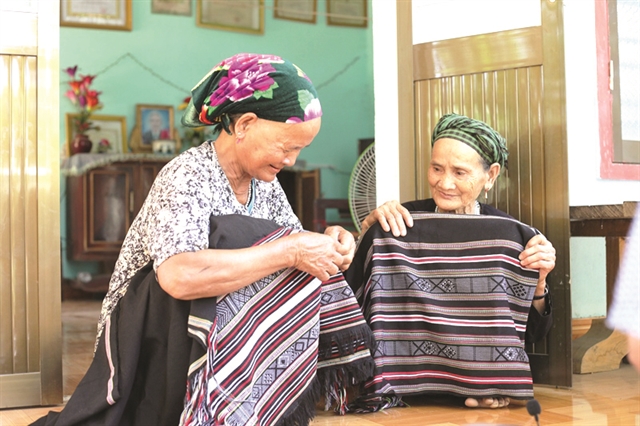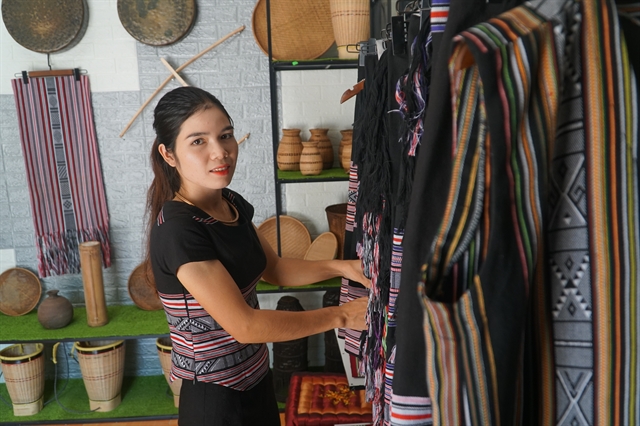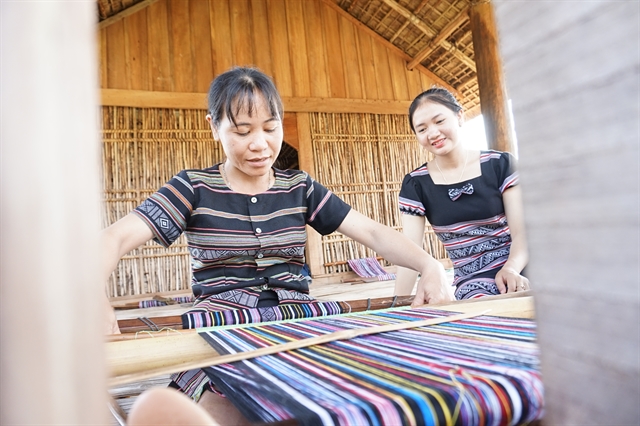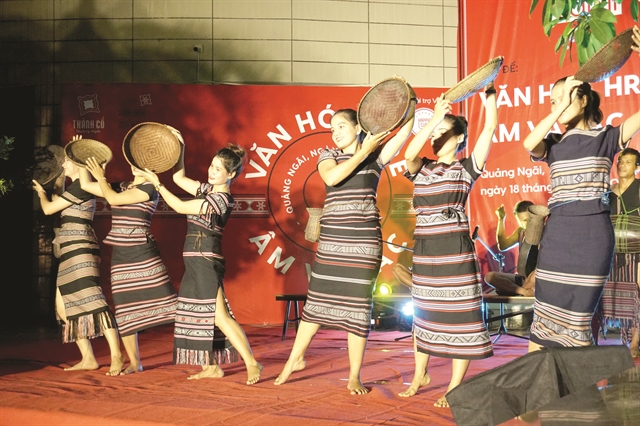 Features
Features

Just a short stroll from a provincial road lies Teng Village in mountainous Ba Tơ District in the central province of Quảng Ngãi, the tranquil home of 200 families from the H’Re ethnic minority and a centre of brocade-making for generations.
by Bùi Hoài Nam

|
| OF CULTURE & TRADITION: Two elderly H’Re artisans with their brocade in Teng Village, Ba Tơ District. Preserved by local villagers for centuries, the craft was recognised as a national intangible heritage in 2019. Photo courtesy of Phạm Linh |
Just a short stroll from a provincial road lies Teng Village in mountainous Ba Tơ District in the central province of Quảng Ngãi, the tranquil home of 200 families from the H’Re ethnic minority and a centre of brocade-making for generations.
Cement and bricks have gradually replaced timber as housing, but the brocade craft has survived from the efforts of a group of both young and old artisans.
Phạm Thị Sung, 32, has turned her home into a showroom, displaying collections of H’Re brocade, gongs, and bamboo and rattan farming tools and kitchenware.
She has been among the leading young artisans aiming to see brocade become a profitable tourism product since the H’Re craft was recognised as a national intangible heritage in 2019.
“The craft is a gift of life given by a mother,” Sung said. “All women learn how to make brocade, which is a dowry for marriage. Most young H’Re girls spend their childhood near a portable loom.”

|
| SELLING POINT: Phạm Thị Sung shows off the brocade collection at her shop in Teng Village. The trade would help promote tourism in the H’Re ethnic village. Photo courtesy of Phạm Linh |
The trade has been preserved by four generations of her family and still provides a livelihood in the poor farming village.
Craftswomen have maintained the skill but cotton and natural dye are no longer found locally.
“Land is now reserved for acacia trees, which are an easy way to make money in hilly terrain, while natural dye, made from roots in the jungle, is costly,” she said.
Having a portable loom means that weaving can be done anywhere, anytime. “Women can carry a baby on their back while making brocade,” Sung said.

|
| TIMELESS CRAFT: Two women demonstrate the making of brocade at the cultural centre in Teng Village. A craft and culture preservation programme has been launched in the area to promote the ancient values of the H’Re ethnic minority. Photo courtesy of Phạm Linh |
The craft is seen as a job for women that fits in with farming and housework.
One piece of brocade, Sung said, can sell for VNĐ400,000 (US$17.4), which is a tidy sum for three or four days of work.
Unique patterns
Brocade is popular among the many ethnic groups in Việt Nam but the H’Re boast unique patterns that make their products stand out from others.
According to cultural researcher Đoàn Ngọc Khôi, the brocade trade came about as the cultures of the Chăm people and the H’Re people began to mix as the former grew their territory centuries ago.
The Chăm, he said, found the Liêng River to be a peaceful place to settle as they expanded southwards.
“They possessed good skills in brocade weaving and ceramics, and brocade began to develop after links were created with the H’Re,” Khôi explained.
“We have found that patterns on ancient Chăm ceramics are repeated on the brocade of the H’Re.”
Phạm Thị Thung, 82, an old artisan, said H’Re craftswomen had created their own style and patterns.
“Red, black and white are the three key colours of all H’Re brocade,” she said. “Black is the colour of buffalo skin, a spiritual animal, while red is the blood of the H’Re people and white is the soul of the group.”

|
| COMING TOGETHER: H’Re women perform a traditional dance in Quảng Ngãi City. A fair is held regularly in the province for the sharing of cultures and experience among different groups and for building craft and cultural links between ethnic groups and tourists. Photo courtesy of the Đoàn Ánh Dương company |
Animal footprints, leaves, flowers, and daily life are the subjects of the unique local designs, and brocade is considered a valuable possession that the H’Re keep throughout their life.
“A H’Re baby is covered by brocade its mother made, and he or she will be buried in brocade,” Thung said. “This is one reason why the craft has been so well preserved.”
Craftswoman Phạm Thị Thiêu said a full-length brocade dress can cost VNĐ800,000, with the cotton accounting for 30 per cent.
The village’s products, however, struggle in the face of poor marketing and a lack of diversity and promotion.
“Our products are only sold locally or in neighbouring communes in Minh Long and Ba Tơ districts,” Thiêu said.
“We design and make scarves, long dresses, shirts, and ties from brocade, but sell them for not much more than the price of the materials.”
She added that brocade is not normally worn as a daily outfit but is common at H’Re festivals and other gatherings.
Business links
Young artisans have promoted the village craft online and on social networks to reach out to customers, fashion retailers, and other craft villages.
Vice director of the provincial Department of Culture, Sports and Tourism, Huỳnh Thị Phương Hoa, said the department launched a H’Re craft and culture preservation programme in Ba Tơ District, and Teng Village is to be like a demonstration model of community-based tourism.
“The department and the H’Re community established a plan to showcase local life and crafts as tourism products,” Hoa said. “Villagers then revived local gong dances, ta lêu and ka choi (duets and lullabies), crafts, and cuisine.”
“Gong dance teams and skilled performers have formed groups to revitalise ancient culture and arts that have faded over the last few decades.”
Farm trips are also being organised, she added, creating further links between travel agencies and the local community.

|
| CLOSE-KNIT: Old and young H’Re women in traditional dress making cakes at a festival in Teng Village. Photo courtesy of Phạm Linh |
Đoàn Ánh Dương, director of the Đoàn Ánh Dương company, said a culture and exhibition fair was organised for the first time last year at the Quảng Ngãi Old Citadel and became a rendezvous point for ethnic groups living in mountainous districts in the province. It also acts as a venue for the sharing of cultures between ethnic groups and tourists and for promoting local crafts.
“We host the fair on the weekend in Quảng Ngãi City -- the provincial capital -- and create opportunities for ethnic groups to introduce their unique crafts, hand-made goods, and culture,” Dương said.
“Villagers can earn more from sales at the fair and also establish business links. The village is also an experiential tourist site that allows for cultural exploration of the ethnic community in the province,” she said.
The preservation of the craft and the training of skilled weavers, she added, will add tourism products to the village’s offerings, and the production of brocade should be diversified into useable and sellable products.
Artisan Sung, meanwhile, said Teng Village’s craft has yet to establish a reputation within the brocade network in central Việt Nam, which includes 17 weaving teams from seven ethnic groups, including the Xơ Đăng, Ba Na, Tà Ôi, Cơ Tu, and Mạ from Đà Nẵng, Quảng Nam, Thừa Thiên-Huế, Kon Tum, and Đắk Nông.
“We plan to approach the network and create links with fashion outlets,” she said. “This would give the village’s craft an opportunity to take off.” VNS




